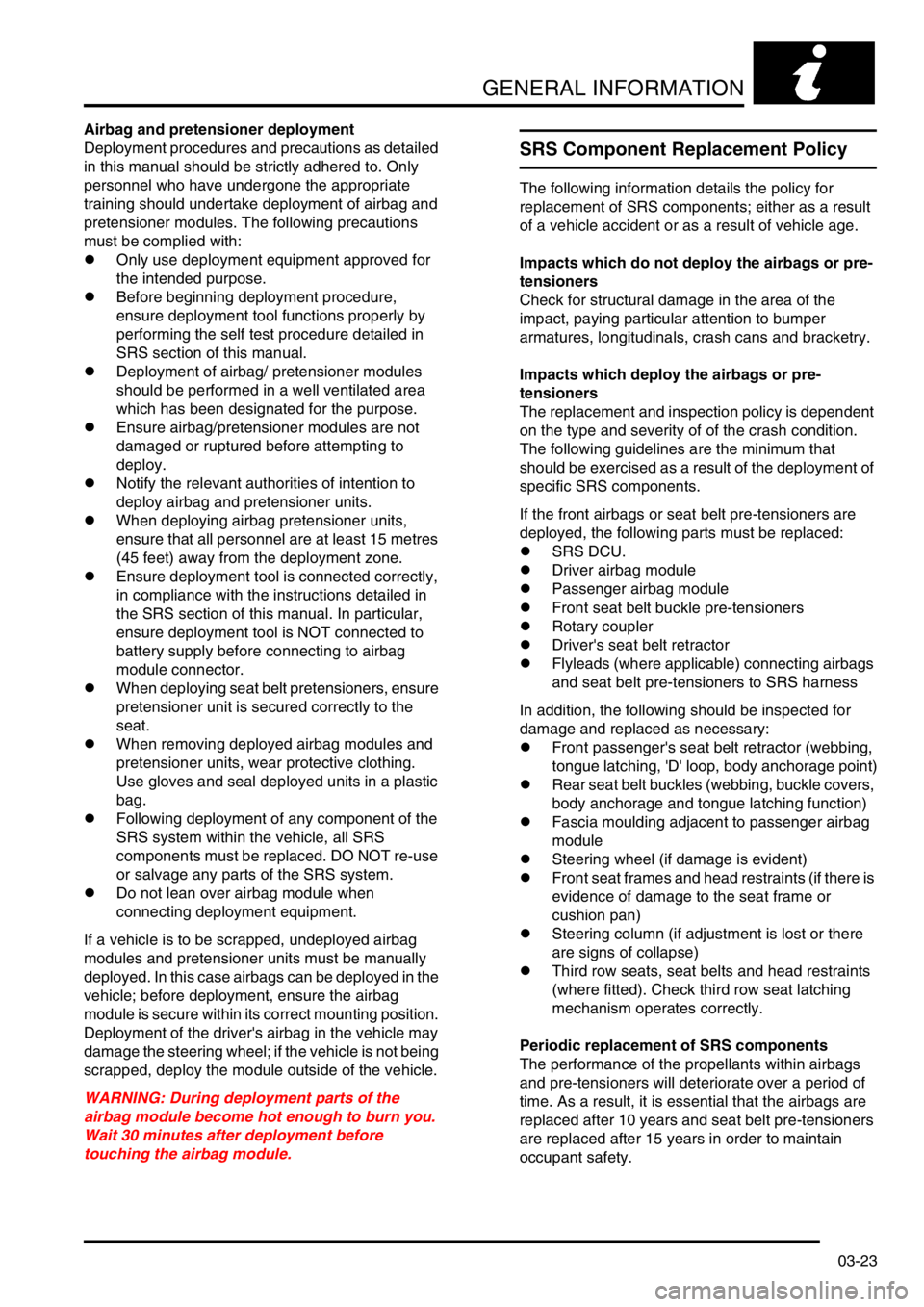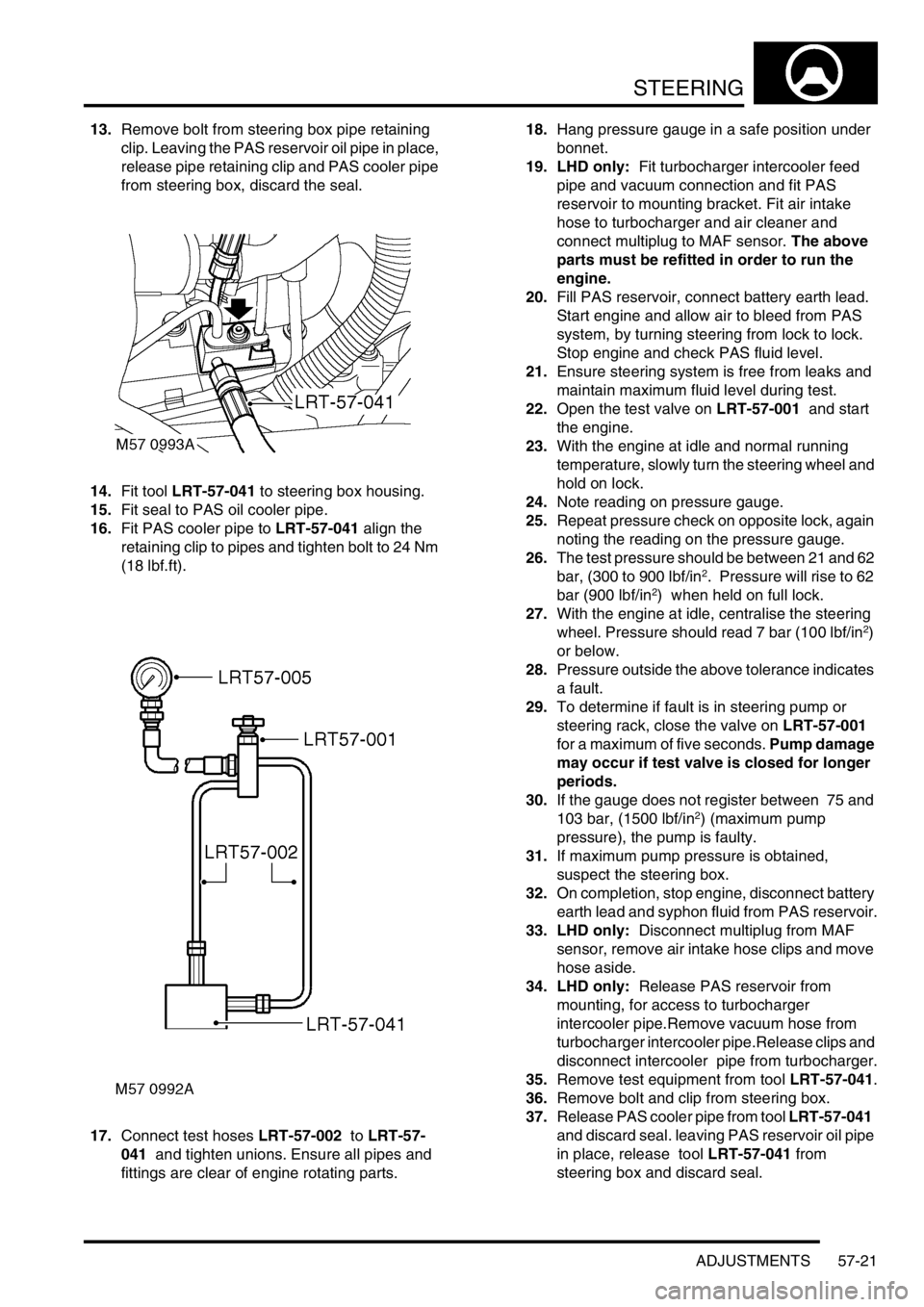steering wheel adjustment LAND ROVER DISCOVERY 2002 Workshop Manual
[x] Cancel search | Manufacturer: LAND ROVER, Model Year: 2002, Model line: DISCOVERY, Model: LAND ROVER DISCOVERY 2002Pages: 1672, PDF Size: 46.1 MB
Page 17 of 1672

CONTENTS
14 CONTENTS
Steering system component layout................................................................................................. 57-1
Steering column assembly and intermediate shaft ......................................................................... 57-2
Steering box.................................................................................................................................... 57-4
Description ...................................................................................................................................... 57-5
Operation ........................................................................................................................................ 57-15
ADJUSTMENTS
Steering box - check and adjust ..................................................................................................... 57-17
Hydraulic system - bleed ................................................................................................................ 57-18
Steering linkage - centralise ......................................................................................................... 57-18
Wheel alignment - front ................................................................................................................. 57-19
Power steering pressure check - diesel models ............................................................................. 57-20
Power steering pressure check - V8 LHD models .......................................................................... 57-22
Power steering pressure check - V8 RHD models ......................................................................... 57-24
REPAIRS
Power steering box - V8 ................................................................................................................. 57-27
Power steering box - LHD - diesel .................................................................................................. 57-30
Steering box - RHD - diesel ............................................................................................................ 57-34
Seal - input shaft - steering box ..................................................................................................... 57-37
Seal - output shaft - steering box ................................................................................................... 57-38
Pump - power steering - V8 ............................................................................................................ 57-39
Pump - power steering - diesel ....................................................................................................... 57-41
Steering column assembly and lock ............................................................................................... 57-42
Shaft - intermediate and universal joint - steering column ............................................................ 57-44
Nacelle - steering column ............................................................................................................... 57-47
Drop arm - steering box ................................................................................................................ 57-47
Ball joint - track rod ....................................................................................................................... 57-48
Ball joint - drag link ....................................................................................................................... 57-49
Drag link ........................................................................................................................................ 57-50
Damper - steering ......................................................................................................................... 57-51
Steering wheel ............................................................................................................................... 57-51
FRONT SUSPENSION .............................................................................. 60-1
DESCRIPTION AND OPERATION
Front suspension component layout (ACE torsion bar shown)....................................................... 60-1
Front suspension components (ACE torsion bar shown) ............................................................... 60-2
Description ...................................................................................................................................... 60-4
DESCRIPTION AND OPERATION
ACE system component layout....................................................................................................... 60-9
ACE system control diagram .......................................................................................................... 60-10
Description - ACE ........................................................................................................................... 60-11
Operation ........................................................................................................................................ 60-25
ADJUSTMENTS
ACE hydraulic system bleeding ..................................................................................................... 60-27
Fluid level check - ACE system ...................................................................................................... 60-27
REPAIRS
Bushes - Panhard rod ................................................................................................................... 60-29
Ball joint - upper - steering knuckle ............................................................................................... 60-30
Ball joint - lower - steering knuckle ................................................................................................. 60-31
Steering knuckle ........................................................................................................................... 60-32
Road spring - front ........................................................................................................................ 60-34
Wheel hub....................................................................................................................................... 60-35
Damper - front ............................................................................................................................... 60-37
Page 58 of 1672

GENERAL INFORMATION
03-23
Airbag and pretensioner deployment
Deployment procedures and precautions as detailed
in this manual should be strictly adhered to. Only
personnel who have undergone the appropriate
training should undertake deployment of airbag and
pretensioner modules. The following precautions
must be complied with:
lOnly use deployment equipment approved for
the intended purpose.
lBefore beginning deployment procedure,
ensure deployment tool functions properly by
performing the self test procedure detailed in
SRS section of this manual.
lDeployment of airbag/ pretensioner modules
should be performed in a well ventilated area
which has been designated for the purpose.
lEnsure airbag/pretensioner modules are not
damaged or ruptured before attempting to
deploy.
lNotify the relevant authorities of intention to
deploy airbag and pretensioner units.
lWhen deploying airbag pretensioner units,
ensure that all personnel are at least 15 metres
(45 feet) away from the deployment zone.
lEnsure deployment tool is connected correctly,
in compliance with the instructions detailed in
the SRS section of this manual. In particular,
ensure deployment tool is NOT connected to
battery supply before connecting to airbag
module connector.
lWhen deploying seat belt pretensioners, ensure
pretensioner unit is secured correctly to the
seat.
lWhen removing deployed airbag modules and
pretensioner units, wear protective clothing.
Use gloves and seal deployed units in a plastic
bag.
lFollowing deployment of any component of the
SRS system within the vehicle, all SRS
components must be replaced. DO NOT re-use
or salvage any parts of the SRS system.
lDo not lean over airbag module when
connecting deployment equipment.
If a vehicle is to be scrapped, undeployed airbag
modules and pretensioner units must be manually
deployed. In this case airbags can be deployed in the
vehicle; before deployment, ensure the airbag
module is secure within its correct mounting position.
Deployment of the driver's airbag in the vehicle may
damage the steering wheel; if the vehicle is not being
scrapped, deploy the module outside of the vehicle.
WARNING: During deployment parts of the
airbag module become hot enough to burn you.
Wait 30 minutes after deployment before
touching the airbag module.
SRS Component Replacement Policy
The following information details the policy for
replacement of SRS components; either as a result
of a vehicle accident or as a result of vehicle age.
Impacts which do not deploy the airbags or pre-
tensioners
Check for structural damage in the area of the
impact, paying particular attention to bumper
armatures, longitudinals, crash cans and bracketry.
Impacts which deploy the airbags or pre-
tensioners
The replacement and inspection policy is dependent
on the type and severity of of the crash condition.
The following guidelines are the minimum that
should be exercised as a result of the deployment of
specific SRS components.
If the front airbags or seat belt pre-tensioners are
deployed, the following parts must be replaced:
lSRS DCU.
lDriver airbag module
lPassenger airbag module
lFront seat belt buckle pre-tensioners
lRotary coupler
lDriver's seat belt retractor
lFlyleads (where applicable) connecting airbags
and seat belt pre-tensioners to SRS harness
In addition, the following should be inspected for
damage and replaced as necessary:
lFront passenger's seat belt retractor (webbing,
tongue latching, 'D' loop, body anchorage point)
lRear seat belt buckles (webbing, buckle covers,
body anchorage and tongue latching function)
lFascia moulding adjacent to passenger airbag
module
lSteering wheel (if damage is evident)
lFront seat frames and head restraints (if there is
evidence of damage to the seat frame or
cushion pan)
lSteering column (if adjustment is lost or there
are signs of collapse)
lThird row seats, seat belts and head restraints
(where fitted). Check third row seat latching
mechanism operates correctly.
Periodic replacement of SRS components
The performance of the propellants within airbags
and pre-tensioners will deteriorate over a period of
time. As a result, it is essential that the airbags are
replaced after 10 years and seat belt pre-tensioners
are replaced after 15 years in order to maintain
occupant safety.
Page 122 of 1672

MAINTENANCE
PROCEDURES 10-13
Check/top-up — Washer reservoir
1.Check fluid level in windscreen washer
reservoir.
2.Clean area around filler cap, remove cap.
3.Top-up if necessary to correct level on reservoir
using recommended fluid.
+ CAPACITIES, FLUIDS AND
LUBRICANTS, Fluids.
4.Fit filler cap.
Steering box
Check
1.Check steering box for fluid leaks.
Adjust
1.Check that there is no backlash in steering box
with road wheels in straight ahead position.
Adjust if required.
+ STEERING, ADJUSTMENTS,
Steering box - check and adjust.
Battery
Check
1.Check battery condition by checking colour of
condition indicator.
lGreen = O.K.
lBlack = Battery requires charging.
lClear/white = New battery required.
Clean
1.Clean and grease battery terminals with
petroleum jelly.
Page 456 of 1672

ENGINE MANAGEMENT SYSTEM - TD5
REPAIRS 18-1-63
Switch - cruise control (set/resume)
$% 19.75.33
Remove
1.Remove the key from the starter switch.
Disconnect both battery leads, negative lead
first. Wait ten minutes before starting work.
2.Remove driver's airbag module.
+ RESTRAINT SYSTEMS, REPAIRS,
Airbag module - drivers.
3.Release remote control switches multiplug and
leads from steering wheel base.
4.Disconnect remote control switches multiplug
from harness.
5.Remove 2 screws securing remote control
switches to steering wheel base.
6.Release and remove remote control switches
from steering wheel.
Refit
1.Fit remote control switches to steering wheel
and secure with screws.
2.Connect remote control switches multiplug to
harness.
3.Secure leads and multiplug to base of steering
wheel.
4.Fit driver's airbag module.
+ RESTRAINT SYSTEMS, REPAIRS,
Airbag module - drivers.
Switch - clutch
$% 19.75.34
Remove
1.Disconnect the multiplug from the clutch switch.
2.Position a container below the clutch switch to
collect the fluid.
3.Unscrew and remove the clutch switch.
CAUTION: Always fit plugs to open
connections to prevent contamination.
Refit
1.Fit the clutch switch and tighten to 10 Nm (7
lbf.ft).
2.Connect the multiplug.
3.Bleed the clutch hydraulic system.
+ CLUTCH - Td5, ADJUSTMENTS,
Clutch hydraulic system - bleed.
Page 890 of 1672

STEERING
DESCRIPTION AND OPERATION 57-3
1Air bag module
2Steering wheel and nut
3Horn switch 2 off
4Radio remote control switch (if fitted)
5Column switches
6Lower nacelle
7Column tilt adjustment lever
8Steering column lock
9Ignition switch and harness
10Upper column assembly
11Lower column
12Universal joint 13Bolt
14Bolt
15Intermediate shaft assembly
16Decouple joint
17Rubber coupling and heat shield
18Bolt
19Universal joint
20Shear bolt 2 off
21Rotary coupler
22Upper nacelle
23Cruise control switch (if fitted)
Page 893 of 1672

STEERING
57-6 DESCRIPTION AND OPERATION
Tilt adjustment
The column tilt adjuster lever mechanism is located on the LH side of the steering column and allows the upper column
tube, nacelle and steering wheel assemblies to be tilted up or down a maximum of 7.5
° or 47 mm (NAS vehicles have
a smaller range of movement than the ROW vehicles).
The pawl of the mechanism is attached to the lower column and is allowed to pivot, a toothed quadrant is fixed to the
upper column tube.
When the lever on the LH side of the steering column is raised the mechanism releases the pawl from the toothed
quadrant, this allows the column to be moved. When the lever is released two return springs pull the pawl into
engagement with the toothed quadrant.
Steering column lock (All except NAS)
The steering column lock houses the ignition switch, ignition illumination light ring, key lock barrel and the alarm
passive coil. The steering lock is attached to the upper column with two shear bolts. The bolts are tightened to a
torque which shears off the heads of the bolts preventing easy removal of the steering lock.
The steering lock operates by a bolt, which emerges when the ignition key is turned to position 'O' and the ignition key
removed. The bolt engages in a lock collar located on the upper shaft in the upper column tube. The lock collar is
attached to the upper shaft by a 'wave form' interference ring. If a high torque is applied via the steering wheel with
the lock engaged, the lock collar will slip on the upper shaft. This prevents damage to the steering lock, yet still
prevents the vehicle from being driven.
Steering column lock (NAS only)
The steering column lock houses the ignition switch, ignition illumination light ring, key lock barrel and the alarm
passive coil. The steering lock is attached to the upper column with two shear bolts. The bolts are tightened to a
torque which shears off the heads of the bolts preventing easy removal of the steering lock.
The steering column lock operates by a bolt, which emerges when the ignition key is turned to position 'O' and the
ignition key removed. The bolt engages in a groove machined into the upper shaft in the column tube.
Steering wheel
The steering wheel comprises a cast centre and wire frame onto which the soft polyurethane foam is moulded. The
steering wheel is located on the upper column shaft by a spline and is secured with a nut. A remote radio control switch
(if fitted) is located on the LH side of the steering wheel, a cruise control switch may be located on the RH side. Horn
switches are located on each side of the centre of the steering wheel and protrude through the airbag module cover.
Both switches are connected by wires to the rotary coupler connector.
Intermediate shaft
One end of the intermediate shaft is attached to the steering column lower shaft by a splined universal joint and a bolt,
the universal joint is part of a rubber coupling assembly. The rubber coupling assembly is covered by a heat shield
and connects to the lower section of the intermediate shaft via a decouple joint. The rubber coupling reduces the
shocks felt by the driver through the steering wheel. A second universal joint on the other end of the intermediate shaft
is held in by a bolt. The universal joint is splined and engages with the splined rotor (input) shaft of the steering box.
The decouple joint consists of a metal plate that has open ended slots, the plate is bolted through the slots into the
other half of the decouple joint. The top half of the decouple joint has a slot that accepts the lower section of the
intermediate shaft. The slotted metal plate clamps the lower section of the intermediate shaft to the top section. An
indicator clip is installed between the slotted metal plate and the top half of the decouple joint.
If the intermediate shaft is compressed in an accident, the slotted metal plate in the decouple joint will disengage if
sufficient force is applied to the front end of the shaft. If the forces involved do not disengage the shaft, the red
indicator clip located in the decouple joint will break off if the shaft moves. The intermediate shaft cannot be repaired
and must be replaced as an assembly if accident damage occurs.
Page 904 of 1672

STEERING
ADJUSTMENTS 57-17
ADJUST ME NTS
Steering box - check and adjust
$% 57.10.13
Check
1.Raise front of vehicle.
WARNING: Do not work on or under a
vehicle supported only by a jack. Always
support the vehicle on safety stands.
2.Remove nut securing drag link to drop arm.
3.Using LRT-57-036, break taper joint and
release drag link.
4.Ensure steering is centralised.
5.With the drop arm held, check for rotational
movement at the intermediate shaft universal
joint. If any movement exists, the steering box
requires adjusting.Adjust
1.Loosen lock nut on steering box adjuster and
tighten adjuster until movement is removed at
universal joint.
CAUTION: Ensure that steering box is
centralised before adjustment. Never over
adjust, free play should just be eliminated.
2.When adjustment is correct, hold the adjuster
and tighten adjuster locknut.
3.Turn steering wheel from lock to lock and check
no tightness exists.
4.Fit drag link to drop arm, and tighten nut to 80
Nm (59 lbf.ft).
5.Remove stands and lower vehicle.
Page 905 of 1672

STEERING
57-18 ADJUSTMENTS
Hydraulic system - bleed
$% 57.15.02
Bleed
1.Clean PAS fluid reservoir around filler cap and
fluid level indicators.
2.Remove filler cap from PAS fluid reservoir. If
necessary, fill PAS fluid reservoir to upper level
indicator with recommended fluid.
+ CAPACITIES, FLUIDS AND
LUBRICANTS, Fluids.
CAUTION: Ensure no dirt is allowed to enter
the steering reservoir when the cap is
removed.
3.Start engine and run to normal operating
temperature.
4.Position container to catch fluid spillage from
steering box.
5.With engine at idle speed, and an assistant
turning the steering from lock to lock, loosen
bleed screw on top of steering box. Keep PAS
fluid reservoir topped up and allow all air to
bleed from system. When fluid from bleed
screw is free of air, tighten bleed screw.
CAUTION: Do not hold steering at full lock
for longer than 10 seconds.
6.Stop engine.
7.Clean spilled PAS fluid from steering box and
surrounding area.
CAUTION: Power steering fluid will damage
paint finished surfaces. If spilled,
immediately remove fluid and clean area
with water.
8.Check fluid level in PAS fluid reservoir and fill to
upper level mark. If fluid is aerated, wait until
fluid is free from bubbles.
9.Fit PAS fluid reservoir filler cap.
Steering linkage - centralise
$% 57.35.05
The following procedure assumes that the front
wheel alignment is correctly adjusted.
Adjust
1.Raise front of vehicle, and position the road
wheels at straight ahead.
WARNING: Do not work on or under a
vehicle supported only by a jack. Always
support the vehicle on safety stands.
2.Remove nut securing drag link to drop arm.
Using tool LRT-57-036 break taper joint and
release drag link from drop arm.
3.Fit centralising bolt to steering box and ensure
that front road wheels are in the straight ahead
position.
4.Loosen clamp bolts on drag link.
Page 906 of 1672

STEERING
ADJUSTMENTS 57-19
5.Adjust drag link so that taper joint is centralised
in drop arm, then tighten drag link clamp bolts:
Tighten M8 bolts to 22 Nm (16 lbf.ft) and M10
bolts to 33 Nm (24 lbf.ft).
6.Connect drag link to drop arm and tighten nut to
80 Nm (59 lbf.ft).
7.Remove steering box centralising bolt.
8.Remove stand(s) and lower vehicle.
9.Road test the vehicle and check that the
steering wheel is centralised. If steering wheel
is not centralised, proceed as follows.
10.Slacken drag link adjuster clamp bolts.
11.Without disconnecting drag link from drop arm,
adjust the length of the drag link to bring the
steering wheel to the central position.
CAUTION: Repositioning the steering wheel
on its splines cannot correct small (less
than 5
°) errors in steering wheel alignment.
Always rectify small errors in alignment by
adjusting the drag link as detailed above,
ensuring that steering box centralisation is
maintained.
12.Tighten drag link clamp bolts: Tighten M8 bolts
to 22 Nm (16 lbf.ft) and M10 bolts to 33 Nm (24
lbf.ft)
Wheel alignment - front
$% 57.65.01
The following is the only wheel alignment equipment
which has been approved.
lBeissbarth ML 4600 wheel alignment computer
(6 sensor).
lBeissbarth ML 4600-8 wheel alignment
computer (8 sensor).
lBeissbarth ML 4000 wheel alignment computer
(8 sensor wireless).
lHunter S411-14.
Check
1.Ensure tyre pressures are correct and vehicle
is at kerbside weight.
2.Roll vehicle backwards and forwards to relieve
stresses in steering and suspension.
3.Ensure road wheels are positioned straight
ahead.
4.Ensure that wheel alignment equipment is
properly calibrated.
5.Following the equipment manufacturer's
instructions, measure the front wheel
alignment. Compare with the figures given in
General Data.
+ GENERAL DATA, Steering.
Adjust
1.Loosen track rod and adjuster clamp bolts.
2.Rotate adjuster to obtain correct alignment.
+ GENERAL DATA, Steering.
3.Tighten track rod and adjuster clamp bolts:
Tighten M8 bolts to 22 Nm (16 lbf.ft) and M10
bolts to 33 Nm (24 lbf.ft).
4.Recheck front wheel alignment.
Page 908 of 1672

STEERING
ADJUSTMENTS 57-21
13.Remove bolt from steering box pipe retaining
clip. Leaving the PAS reservoir oil pipe in place,
release pipe retaining clip and PAS cooler pipe
from steering box, discard the seal.
14.Fit tool LRT-57-041 to steering box housing.
15.Fit seal to PAS oil cooler pipe.
16.Fit PAS cooler pipe to LRT-57-041 align the
retaining clip to pipes and tighten bolt to 24 Nm
(18 lbf.ft).
17.Connect test hoses LRT-57-002 to LRT-57-
041 and tighten unions. Ensure all pipes and
fittings are clear of engine rotating parts.18.Hang pressure gauge in a safe position under
bonnet.
19. LHD only: Fit turbocharger intercooler feed
pipe and vacuum connection and fit PAS
reservoir to mounting bracket. Fit air intake
hose to turbocharger and air cleaner and
connect multiplug to MAF sensor. The above
parts must be refitted in order to run the
engine.
20.Fill PAS reservoir, connect battery earth lead.
Start engine and allow air to bleed from PAS
system, by turning steering from lock to lock.
Stop engine and check PAS fluid level.
21.Ensure steering system is free from leaks and
maintain maximum fluid level during test.
22.Open the test valve on LRT-57-001 and start
the engine.
23.With the engine at idle and normal running
temperature, slowly turn the steering wheel and
hold on lock.
24.Note reading on pressure gauge.
25.Repeat pressure check on opposite lock, again
noting the reading on the pressure gauge.
26.The test pressure should be between 21 and 62
bar, (300 to 900 lbf/in
2. Pressure will rise to 62
bar (900 lbf/in2) when held on full lock.
27.With the engine at idle, centralise the steering
wheel. Pressure should read 7 bar (100 lbf/in
2)
or below.
28.Pressure outside the above tolerance indicates
a fault.
29.To determine if fault is in steering pump or
steering rack, close the valve on LRT-57-001
for a maximum of five seconds. Pump damage
may occur if test valve is closed for longer
periods.
30.If the gauge does not register between 75 and
103 bar, (1500 lbf/in
2) (maximum pump
pressure), the pump is faulty.
31.If maximum pump pressure is obtained,
suspect the steering box.
32.On completion, stop engine, disconnect battery
earth lead and syphon fluid from PAS reservoir.
33. LHD only: Disconnect multiplug from MAF
sensor, remove air intake hose clips and move
hose aside.
34. LHD only: Release PAS reservoir from
mounting, for access to turbocharger
intercooler pipe.Remove vacuum hose from
turbocharger intercooler pipe.Release clips and
disconnect intercooler pipe from turbocharger.
35.Remove test equipment from tool LRT-57-041.
36.Remove bolt and clip from steering box.
37.Release PAS cooler pipe from tool LRT-57-041
and discard seal. leaving PAS reservoir oil pipe
in place, release tool LRT-57-041 from
steering box and discard seal.